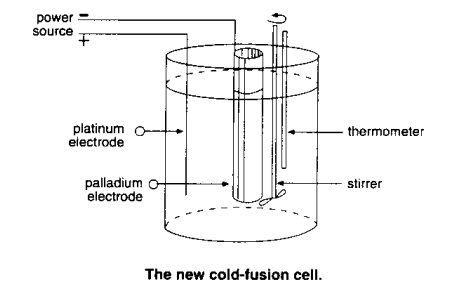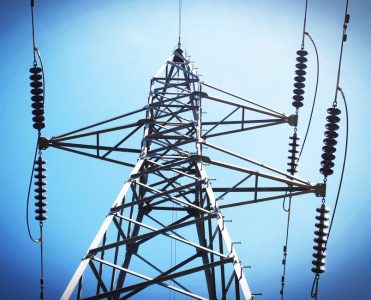Genie in a Jar The “Discovery” of Cold Fusion
On March 23, 1989, chemists Martin Fleischmann and Stanley Pons stood the world of science on its head by announcing that they had achieved what hundreds of nuclear physicists had failed to achieve: sustainable nuclear fusion. The announcement could not have been more stunning if the pair had captured a genie in a jar. At a press conference hosted by the University of Utah, Pons’s home institution, the two chemists described their apparatus. Not a billion-dollar hot-fusion reactor but a simple glass electrolytic cell, some heavy water, a palladium electrode and a platinum one. The total cost of the apparatus came to perhaps a hundred dollars.
The fusion of two atoms into one releases tremendous amounts of energy, even more than the fission of a single atom into two. A hydrogen bomb, which operates by nuclear fusion, releases vastly more energy than an atomic bomb of the same mass. Although scientists developed working fission reactors before they constructed the first atomic bomb, things are the other way around with fusion. Several decades after the first successful hydrogen bomb test, scientists have yet to build a successful fusion reactor.
To a world increasingly dependent on energy, a fusion reactor would prove an inestimable boon. Unlike fission, no exotic heavy metals like uranium are needed to drive the fusion process. It would work with simple atoms like hydrogen and fuse them into new atoms such as helium, essentially what happens in the center of the sun. Since almost all the energy that we enjoy at present comes directly or indirectly from the sun, one might say that we have been using a giant fusion reactor from the beginning of human life on Earth. The fuel for a fusion reactor closer to home is abundant, to say the least. Every molecule of water contains two hydrogen atoms. Successful, sustainable fusion, although a real possibility, has a magical air about it. It would be a true genie, able to grant any and all energy wishes at the flick of a switch.
Thee process we might call “hot fusion” would work by driving atoms together under tremendous heat and pressure to ensure that fusion takes place. Current designs require not a jar but something like the enormous doughnut-shaped vessel called a Tokamak. Inside the Tokamak, a sophisticated plasma sustained by powerful magnetic fields sets up a frantic dance of atoms and particles that is statistically guaranteed to produce collisions between two nuclei in the plasma. The tremendous energies are necessary because atomic nuclei have similar charges and repel each other. Once atoms begin to fuse, however, the energy released keeps the process going and provides additional energy in superabundance. At the time of the earth shaking announcement by Fleischmann and Pons in March 1989, nuclear physicists had coaxed the fusion genie into the heart of just a few reactors and for only the briefest appearances, milliseconds at a time.
Reactions to the announcement ranged from exaltation and greed to fear and scorn. Because Fleischmann and Pons were well-respected scientists, each with many publications to his name, the press felt safe in declaring the dawn of a new age of cheap and abundant energy. Average people, watching the news on their television sets, felt a positive surge of confidence in the future. Fortune 500 companies perked up their ears. Fusion in a Jar? Time to get in on the ground floor. Within hours of the press conference and for days after, calls poured in to the University of Utah, many from firms offering to make the technology widely available—in return for a license!
Privately, more than a few nuclear physicists who assumed that the revelation had already been checked by their colleagues, felt simultaneously amazed and let down. Imagine! None of the high-tech equipment, none of the extensive theorizing, was necessary. A pair of smart-aleck chemists had beat them to the punch and made the whole hot-fusion effort look ridiculous. But as they learned more details of the Fleischmann-Pons experiments, they became increasingly skeptical. It was a bit like hearing that someone had made a nuclear reactor from a soup can. The skeptics had plenty of questions. For one thing, Fleischmann and Pons must have found lots of neutrons or protons coming from their jars. Did they? Had they found any of the typical fusion products such as helium or its isotopes?
More than a few chemists, aware that big-time physics had captured the lion’s share of the headlines for years, may have smarted from time to time at what they took to be a certain air of superiority among physicists. Without a doubt they felt a certain glee at the thought of upstaging those fancy hot-fusion reactors with a simple electrolytic cell.
The actual announcement made by Fleischmann and Pons, even the paper they distributed at the conference, was maddeningly short on details. Within days of the announcement, hundreds, indeed thousands, of scientists around the world attempted to duplicate the experiment. Although a number of laboratories claimed to have duplicated Fleischmann and Pons’s results, many more did not. Indeed, so many of the more careful attempts at duplication failed that the experiment came to be regarded as non repeatable, a cardinal sin on the face of things. The full story, however, has two parts. One is technical, the other human.
Fleischmann and Pons reported that their electrolytic cells produced more heat than they consumed. They also reported neutrons, but not at the correct energies and in numbers that were far below what physicists would expect if the pair had really captured the fusion genie in a jar. Explanations for the anomalous heat and the low neutron count have since appeared in the rather large literature on cold fusion. Is the dream dead? I’ll come to that at the very end. In the meantime, the other half of the story reveals how Fleischmann and Pons came to believe that they had captured the fusion genie. They were already aware that others might not find the experiment repeatable. All too frequently, even their own cells failed to produce excess heat. Their reaction to this frustrating but apparently unavoidable feature of cold fusion illustrates what happens when more or less ordinary people get caught up in extraordinary events. Fleischmann and Pons lost their scientific patience. They gambled.
Dreaming of the Genie
It was Fleischmann who first dreamed of harnessing fusion in a jar. As an electrochemist, he was well aware how smallish electric currents passing through a chemical solution could sometimes cause reactions that would otherwise require exotic conditions. For example, to split sodium chloride (table salt) into its constituent atoms of sodium and chlorine by heat alone would take a temperature of 40,000 degrees centigrade. But if one merely dissolved the salt in ordinary water and passed a modest 4-volt current through it, the sodium and chlorine atoms would separate into ions, charged atoms with an excess or defect of one electron.
For years Fleischmann had been intrigued by the near magical power of the metal palladium. When used as an electrode, it could soak up hydrogen ions like a sponge. Could it be that if enough ions entered the palladium, they would be forced into fusing? In l984 he had just taken early retirement from the University of Southampton in England. That year he visited his former student and erstwhile coresearcher, Pons, in Utah The two had already published numerous papers together in other areas of chemistry, but this time, fusion was very much on their minds. Fleischmann wondered if it wasn’t time to take a flyer on this wild idea. One night over a glass of whiskey in Pons’s kitchen, Fleischmann said, “It’s a billion-to-one chance. Shall we do it?” Pons replied, “Let’s have a go.”
The two had already done some library searching and turned up some intriguing hints that low-energy fusion might be possible, after all. Did they know that they were not the first to dream?
In 1926 two German scientists, Friedrich Paneth and Kurt Peters, had reported the spontaneous transformation of hydrogen into helium in the Journal Die Naturwissenschaften. The announcement created quite a stir at the time, not because it meant free nuclear energy, but because it meant a new source of helium that could be used as a safe lifting gas in dirigibles and airships. Helium was extremely rare and difficult to produce at the time. The Paneth-Peters process involved the absorption of hydrogen gas by finely ground palladium. The two had measured small but quite definite amounts of helium apparently produced by the process. Later, however, they had to retract their claims when another researcher carefully repeated the experiment and found that the helium was being emitted by the experiment’s glassware!
In 1927, Swedish scientist John Tandberg attempted to adapt the Paneth-Peters process to electrolysis. Ordinary water served as a source for hydrogen ions. The electric current in the electrolysis vessel forced the hydrogen into a palladium electrode where Tandberg thought it would be catalyzed by the metal, producing in the process “helium and useful reaction energy.” In a patent application he claimed to have found a “significant increase in efficiency,” meaning that the reaction seemed to consume less energy than it should, a hint that some energy was actually being produced. Tandberg’s application was refused on the grounds that his description of the process was too sketchy.
Perhaps because of the first successful H-bomb tests, the 1950s witnessed an upsurge of interest in fusion. In parallel to the hot-fusion research effort then getting underway, people still sought an easy route to limitless energy. In 1951, Argentinean dictator Juan Peron announced that a secret national research facility, directed by former Nazi scientist Ronald Richter, had successfully tested a fusion reactor. When the effort was discovered to be bogus, Richter was arrested and the three hundred scientists working on the project were sent home. The “reactor” consisted of a giant chamber in which a spark gap was supposed to ignite a fusion reaction in a mixture of hydrogen and lithium gas. Apart from soaking hydrogen or deuterium into metals, there turned out to be another route to low-energy fusion. In 1947 British physicist Charles Frank discovered a new particle which he called the mu-meson, or muon for short. The new particle had the same charge as an electron, but 207 times the mass. Among other things, this meant that a muonic hydrogen atom (in which the heavy muon replaced the light electron in its orbit around a single proton) would have 1/207 of the diameter of an ordinary hydrogen atom, such atoms could be brought much closer together before they experienced the repulsion that keeps nuclei from approaching each other too closely. Physicists theorized that such atoms might fuse more readily. In 1956 Louis W. Alvarez at the University of California at Berkeley actually observed muons catalyzing the fusion of deuterium atoms. The finding was genuine but the method did not lead to a fusion reactor; the cost of producing muons was (and remains) too great.
The work of Frank and Alvarez began a stream of legitimate research that continues to this day. Among the more recent researchers in the field was Steven Jones, a physicist who himself would become the catalyst in a more human reaction. Working at Brigham Young University, a mere 50 miles south of the University of Utah, Jones had already been studying muon catalyzed cold fusion but had recently shifted his research effort under the urging of a colleague, Paul Palmer. In 1986 Jones and Palmer began experimenting with electrolytic cells using ordinary water at first, then 10 percent heavy water and various other mixes. Jones thought he detected excess neutrons emanating from the cell but his neutron detector was too crude to make the measurement precise enough. He spent the next year and a half building a sophisticated neutron spectrometer, and by 1988 he felt ready to confirm his earlier finding of a slight excess of neutrons (above the background level) coming from his electrolytic cells. But back to our main subjects.
When Fleischmann and Pons began their first cold-fusion experiments in 1984, they agreed to work in secret. Part of the reason for this was undoubtedly the potential embarrassment of a colleague discovering their oddball project. Moreover, to conduct the experiment on an official basis, especially if they were to seek funding, they would have to comply with troublesome university procedures designed to protect scientists, subjects, and the world at large from various hazards, including nuclear ones. In deciding to work in this manner, the two began a pattern that would continue right up to the time of the fateful press announcement—and beyond. An obsession with secrecy, especially later when they thought they were witnessing fusion on a regular basis, would undermine their work in critical ways.
After some initial experiments in Pons’s home, the two moved their venue to a laboratory in the basement of the University of Utah chemistry building. Their first run of serious experiments was designed as a probe into the possibilities. They began with simple electrolytic cells and used lithium deuteroxide as an electrolyte. This was a compound of lithium (the next heavier element to helium), deuterium, and oxygen. They used a small block of palladium as the cathode, of course. They had what they thought were good theoretical reasons for believing that fusion would take place in the palladium. Using a formula called the Nernst Equation; they calculated that when the palladium became fully charged with deuterium, the metal would exert an enormous pressure on the particles, some 1,027 atmospheres, well in excess of the pressures achievable in today’s hot-fusion reactors. Naturally, this excited the pair and heightened their expectations further. As it would later turn out, they had misapplied the formula. The actual pressure predicted by the formula was well below the one required for fusion.
Fleischmann and Pons knew that if fusion took place in their cells, neutrons might emanate from the palladium. They installed a simple neutron detector of the type used as a safety monitor near atomic reactors. As electrochemists, they were more interested in heat than radiation, of course. They immersed their cells in a calorimeter, essentially a water bath kept at a constant temperature. The temperature difference between the cell and the bath would give them an idea of how much heat was escaping from the cell. Using a standard formula, they could convert the rate of heat leaving the cell into watts, a measure of the power contained in the heat. The current and voltage entering the cell, when multiplied together, also gave them a figure in watts. They only had to compare the two numbers to know whether a cell was actually producing more power than it took in. Because the experiment was not an official one, they paid for most of the materials and equipment themselves.
As they ran their experiments, they discovered to their amazement and great delight that sometimes their apparatus produced excessive heat, more than they could account for on the basis of the charging current that flowed through the cells from their power supply. It also exceeded the amount of heat that could be caused by any known chemical reaction. The phenomenon was elusive and only appeared after the palladium cathodes had been charging for several days or more. They began to refer to the cathodes that seemed to produce excess heat as “live,” the other cathodes as “dead.” As experienced scientists, Fleischmann and Pons were aware that some subtle effect of the electrolysis or some flaw in their measurement might just be responsible for the seeming phenomenon. During the early period, they proceeded slowly, as if reluctant to be drawn into the clutches of a false hope.
But something strange happened in the basement laboratory one night while the experiments ran untended: One of the cells exploded, seriously damaging the floor and some of the nearby equipment. Fleischmann was away in England at the time and the degree to which this event excited the two can scarcely be imagined. Pons phoned Fleischmann directly. Fleischmann’s more or less immediate reaction was terse: “We had better not talk about this on the phone.” Had the genie paid them a visit?
This event became famous after the fateful press conference. Cold-fusion supporters cited it as evidence of a nuclear explosion. Cold-fusion skeptics thought that the most likely explanation involved a natural cavity inside the palladium. A buildup of deuterium in the cavity, even at the relatively low pressure dictated by the Nernst equation, might well be enough to explode the block when the deuterium concentration reached the strain limit of the metal. Fleischmann and Pons decided to scale the experiments down, substituting a cylindrical palladium foil for the earlier palladium blocks. A new excitement gripped the pair, and they began to work in earnest.

At this stage, their typical experiment emerged. They would allow a cell to run for several days to “charge up” the palladium with deuterium, then begin careful temperature measurements to see if their cell was generating heat. On several occasions cells appeared to produce excess heat, typically between 10 percent and 25 percent. Using a process he called Scaling ups Fleischmann theorized that based on these figures, a much larger cell with a larger palladium electrode would produce 4 watts of heat for every watt of electrical power input to the cell. The two would cite these figures at the March 23 press conference as if they had actually achieved them.
The simple neutron detector also sometimes showed a neutron count that seemed to exceed the background level (as measured by the same instrument). On one occasion, the count went 50 percent above background level. The two must have been aware, even vaguely, that if fusion was occurring in their cells, the amount of heat being given off should have been accompanied by a lot more neutrons than they were detecting.
The fisherman who snags an old boot experiences great excitement. It may not be fighting much, but if it’s heavy, he might well think, “I have something!” Fleischmann and Pons had measured heat that was well in excess of any chemical reaction they could think of. Theorizing vaguely as they went, they simply postulated an “unknown nuclear process,” one that would produce relatively few neutrons, even none at all. Because their experiments sometimes took weeks, involving long waits while the palladium electrodes charged up, the two continued to pursue other scientific and professional activities. Life went on as before but each man carried a terrible secret in his heart. They had something.
The fisherman who snags an old boot experiences great excitement. It may not be fighting much, but if it’s heavy, he might well think, “I have something!” Fleischmann and Pons had measured heat that was well in excess of any chemical reaction they could think of. Theorizing vaguely as they went, they simply postulated an “unknown nuclear process,” one that would produce relatively few neutrons, even none at all. Because their experiments sometimes took weeks, involving long waits while the palladium electrodes charged up, the two continued to pursue other scientific and professional activities. Life went on as before but each man carried a terrible secret in his heart. They had something, on again-off-again nature of their results, but also to determine some of the design constraints on a useful cold-fusion reactor. To vary so many parameters at the same time would require a lot of cells and a great deal of sophisticated equipment, not to mention a new neutron counter. The two decided to draw up a grant proposal that they subsequently submitted to the Basic Energy Program of the U.S. Department of Energy (DOE).
Had things proceeded normally at this point. Fleischmann and Pons would have received the DOE grant in due course and done the new suite of experiments. They might well have discovered that no combination of parameters would result in a reliably reproducible experiment. They might even have taken b nuclear physicist into their confidence. Of course, it is very hard to take anyone into your confidence when you think you’re sitting on the most important scientific discovery ever made. In fact, it must have taken the pair a long time to word the proposal so as to describe what they were up to without explaining the application they had in mind.
It takes nothing more than normal amounts of ego to explain what happened next. If you think you’re sitting on the most important scientific discovery of all time, you live in fear that some other researcher may beat you to it. Enter Steven Earl Jones at nearby Brigham Young University, the scientist just down the road who had recently built a new neutron spectrometer in his pursuit of low-energy fusion.
It may sound coincidental that the DOE sent Fleischmann and Pons’s grant proposal to Jones for refereeing, but the selection was natural. Jones was well known for his work in low energy fusion, had a good research track record, and had evaluated other proposals for the DOE. When Jones read the proposal he boggled. Two chemists a mere 50 miles away were proposing to carry out experiments that were alarmingly similar to his. Jones took the unprecedented step of asking the DOE funding director if any objections might be raised to his contacting the applicants. Jones’s desire to contact the pair seems to have been motivated by a generous spirit. Perhaps they would like to use his new neutron spectrometer. They might consider working with him or, at least, coordinating publications. Jones, in any event, did not think he was sitting on the discovery of the millennium.
When Jones contacted Fleischmann and Pons in the fall of 1988, the pace of events picked up considerably. Jones, who planned to address a meeting of the American Physical Society in May 1989, submitted an abstract early in the New Year. Their hands now forced, Fleischmann and Pons visited Jones in his Brigham Young laboratory after discussing their results, the three agreed to submit separate manuscripts. Simultaneously, to the prestigious science journal Nature on March 24.
The effect of the meeting on all three participants can only he guessed. Clearly the two sets of experiments only served to reinforce the impression of each scientist that he was on the right track. At the same time, the agreement provided fertile ground for suspicion. What if the other party reneged and published first? For example, did Fleischmann and Pons violate the spirit (if not the letter) of this agreement by sending a paper on cold fusion well before March 24 to the Journal of Electroanalytical Chemistry without telling Jones? Enter the university administrators.
When Pons first approached President Peterson of the University of Utah to announce that he and Fleischmann had apparently discovered a process that produced fusion at room temperature, great excitement spread through the upper echelons. If cold fusion were a reality and the claims of Fleischmann and Pons were correct, the university would become immensely famous and wealthy. But in sharing the dreams of wealth and fame with the pair, the university became vulnerable to the same fear of being scooped. The air of Secrecy spread to the administrative offices.
For one thing, University of Utah administrators and legal staff worried about Steven Jones at nearby Brigham Young University. Almost from the beginning of contact between their own two chemists and the physicist at Brigham Young, there had been a parallel contact between the two universities. However, University of Utah administrators were far more excited about the financial prospects than their counterparts at Brigham Young. Jones claimed no excess heat from his own experiments, merely a low level of neutron emission that barely exceeded background levels. On the other hand, if there was credit to be shared, the Brigham Young people were not prepared to take a back seat to anybody
Even as University of Utah attorneys began to file patent applications, the two sets of administrators met to altar the air and come to an agreement about proceeding jointly. On March 6, the presidents of both universities, along with Jones, Fleischmann, and Pons met at Brigham Young to discuss cooperating in the matter of publication. All agreed that on March 24 the two research groups would each submit a paper to Nature, sending them off in the same courier package.
Shortly after, something spooked the University of Utah. Was it the fear that the press had already heard rumors of the cold-fusion work? Would Jones’s work undercut their patent claims? The university abruptly decided to hold a press conference on March 23, one day before the agreed-upon date for filing the two papers.
The crisis was coming to a head. In deciding to hold the press conference, they did not even inform their own physics department! Jones, who learned of the Conference only a day in advance, felt deep disappointments As far as he was concerned, the March 6 agreement ruled out such an announcement. Pons and Fleischmann did not feel that way, nor did University of Utah administrators. In fact, shortly after the press conference, a reporter asked one of the Utah principals at the March 6 meeting whether he knew of any similar work elsewhere. The reply was negative.
Up to the moment of the press Conferences Fleischmann had both good news and bad news. On one hand, the DOE had approved their grant application for some $322,000 and the Journal of Electroanalytical Chemistry had accepted their paper. The one that would confirm their discovery and square things with the world of science. After all, in the normal course of events, scientists must publish first, then await review of their work by peers. The bad news was the neutron data. They needed confirmation of neutrons, but did not want it from Jones since it would mean that Jones would share the credit. Fleischmann contacted friends at Harwell, the British atomic research establishment, to see whether they could duplicate his setup and measure neutrons. Although Harwell could not comply in time, the prestigious British nuclear laboratory began intensive secret experiments that would last until June of that year. In the meantime, Fleischmann and Pons hired a radiologist to take gamma ray measurements in the vicinity of heat- generating cells.
Fleischmann and Pons felt they needed another eighteen months of quiet research, but events seemed increasingly out of their hands. The stakes in their gamble had suddenly doubled. It was one thing to bet a few years of part-time research on what Fleischmann had called a “billion-to-one” chance. As long as no one knew, the damage to reputations would be minimal if it all came to nothing. But now they had a lot to lose. They evidently decided to make the best of a bad situation and go for broke. If they had really captured the fusion genie in a jar, all they had to do was announce their findings and other scientists, especially physicists would merely confirm the finding. Theirs would be the glory, for ever and ever.
The Nightmare
It began with lights, cameras, and more action than either Pons or Fleischmann had ever imagined. The press conference at the University of Utah on March 23, 1989, brought representatives of every major network and wire service, along with reporters from major newspapers and magazines. To this assemblage Fleischmann and Pons announced that they had achieved sustained fusion in a jar. In particular, they implied that their experiment was very easy to replicate and that there would be no particular difficulty in scaling it up to useful reactor size. Head lines around the world trumpeted the dawn of a new age of cheap and limitless energy. Amid the blaze of lights and the incessant questions, Fleischmann and Pons must have felt like “the thermodynamic duo,” as some reporters called them. They had become major celebrities overnight.
The heady times extended throughout the evening, on into the next day, and for weeks afterward. Meanwhile, scientists around the world were attempting to find out more about the experiment. Requests for information poured into the University of Utah by mail, e-mail, and telephone. What were the dimensions of the cell? What current and voltage were appropriate? What type of palladium had the pair used? The lucky ones got preprints of the paper that would later appear in the Journal of Electroanalytical Chemistry. Copies of the precious preprint, in complete and riddled with errors as it was, multiplied like lemmings.
The press conference had blindsided normal scientific routine. Attempts to replicate the experiment were often based on incomplete, inaccurate, or misleading descriptions of the experiment. Scientists could only forge ahead with what they had, filling in the details with guesses about what Fleischmann and Pons had done. This created another potential abuse of the scientific method: If a scientist failed to get the proper experimental results, Fleischmann, Pons, and their rapidly growing body of supporters could simply claim that the scientist in question hadn’t used the right equipment or procedure.
When major laboratories announced failures to duplicate the experiment, Fleischmann and Pons may have been annoyed, but the thermodynamic duo had only themselves to blame. They had told the scientific world that cold fusion was a reality. The attempt by a group at the Massachusetts Institute of Technology illustrates the difficulties. Led by physicist Stanley Lockhardt, a team at the M.I.T. Plasma Fusion Center attempted to duplicate the experiment. They didn’t want to be accused of using the wrong materials or methods, and the preprint was inadequate for their purpose. The group was forced into the rather unscientific procedure of using network videos of the Utah laboratory to see how many cells Fleischmann and Pons had used, how the cells were wired, and so on. They had to obtain the diagram of a typical cell from a copy of the Financial Times of London!
The M.I.T. group tried for a week, once they had set up their apparatus, but got none of the effects that Fleischmann and Pons had claimed for their process. They reported “no fusion” to the press.
The nightmare was just beginning for Fleischmann and Pons. But for a while the dreamlike atmosphere persisted. On April 10, the Wall Street Journal printed the headline COLD FUSION EXPERIMENT IS REPORTEDLY DUPLICATED. At a Dallas press conference, a team of scientists from Texas A&M University reported 90 percent excess heat output from one of their experimental cells. Fleischmann and Pons were tremendously pleased and excited. As if to heighten the euphoria, another team at Georgia Tech announced neutrons emanating from their fusion cells. In the next four days more confirmations and partial confirmations came from a few other North American labs, as well as from India and Russia. Then, on April 15, two graduate students at the University of Washington in Seattle, Van Eden and Wei Liu, announced that they had measured large amounts of tritium (a possible fusion byproduct), emitted by their experimental cell. They too held a press conference. As one columnist put it, science was now being done by press conference.
The Fleischmann-Pons strategy of going for broke seemed to be paying off, and Fleischmann’s doubts evaporated. Cold fusion was undoubtedly real.
But the nightmare returned almost immediately. On April 15, Georgia Tech retracted its claim to have found neutrons. Their counter, it turned out, was sensitive to heat. Then nine days later, even as more confirmations came in, the Texas A&M group also retracted their claim. They had not grounded their thermometer properly, and the current flowing through it had heated it up, giving an exaggerated reading.
At this point, the number of labs reporting negative results began to exceed the number that claimed positive ones. Fleischmann and Pons began speaking less and less to the press. They apparently granted interviews only to journalists who appeared to believe in cold fusion. On May 18 Nature published a damaging article by Richard D. Petrasso of M.I.T. The physicist demolished the claims of Fleischmann and Pons to have measured neutrons via gamma rays at the 2.224 MeV energy. Worse yet, on May 25 the University of Washington graduate students Eden and Lui reported that they had made a mistake: They had not found tritium after all, but another tri-atomic molecule that was fairly common in their environment.
Although some laboratories and individual scientists continued to report some neutronic or heat effects, the major laboratories now began to sound the death knell of cold fusion. On June 15 the British laboratory at Harwell, which had finally completed its million-dollar intensive cold-fusion experiments (under Fleischmann’s original direction), reported no fusion. Over the summer, the California Institute of Technology, Oak Ridge National Laboratory, and other major national labs reported no fusion. A special panel convened by President Bush under the aegis of the Department of Energy spent the summer visiting various sites and examining firsthand the evidence for cold fusion. In the fall, this panel also reported that there was no evidence for cold fusion as claimed by Fleischmann and Pons.
By August 7, when the University of Utah sponsored the first annual meeting of the National Cold Fusion Institute, it must have seemed strange to the two electrochemists to find themselves surrounded by two hundred “believers,” as they were then coming to be called. From this point on, however, the number of believers began to dwindle steadily. The dream was dying and somewhere (but not in a jar) the fusion genie laughed a hollow laugh.
On October 23 no one could find Pons, and his house had been put up for sale. On January 1, 1991, the University of Utah announced the resignation of Pons. Peterson had already resigned as president of the University of Utah that summer. In the next summer, on June 30, the National Cold Fusion Institute closed permanently.
As individuals, Fleischmann and Pons had taken an extra ordinary gamble and lost. They lost, in the end, not because they were anxious for Nobel prizes or great wealth. Such factors may explain why they gambled. But they lost because they were wrong. They were wrong about the neutrons and wrong, apparently, about the excess heat being radiated by their electrolytic cells.
Yes, We Have No Neutrons
Perhaps the most damning evidence against cold fusion came from the living presence of Fleischmann and Pons themselves at the press conference. They claimed not only heat but also neutrons were given off by the fusion process. They attributed this neutron radiation to a nuclear process in the palladium as it absorbed its limit of deuterium ions. Nuclear physicists who watched the press conference and heard the figure “watts of heat” would have known that the number of neutrons that should have accompanied such heat would have led to quite serious health problems for the pair long before the press conference. Instead of less than a hundred neutrons per second, the pair should have been bathed in a deadly spray of some thousand billion neutrons per second.
Another criticism that physicists leveled at the pair concerned their original measurement of neutrons by their crude counter, called a BF3. Experiments with this counter at Georgia Tech revealed that it was very sensitive to heat. When brought near even a moderate heat source, it would begin to register a higher count of “neutrons.” The Georgia Tech team that had earlier announced a replication had discovered the fatal flaw in the BF3 counter by experimenting with it.
Throughout the neutron debate, as the evidence for neutrons began to crumble before their very eyes, Fleischmann and Pons stuck to their theory that an “aneutronic” nuclear process was responsible for the heat. In the long run, the neutrons didn’t really matter.
Turning Up the Heat
At the press conference, Fleischmann had claimed “4 watts of heat output for every watt input.” Later, on May 8, Fleischmann would turn up the heat by announcing experiments where their cells put out fifty times the energy put in. Perhaps with the neutron side of things going so badly, it was time to emphasize the heat even more. But the heat they had measured came under attack almost as swiftly as the missing neutrons.
When Fleischmann spoke at Harwell five days after the fateful press conference, a scientist in the audience asked him whether he and Pons had done any control experiments. Had they, in fact, done identical experiments with ordinary water replacing the heavy water in the cells? Fleischmann replied, “I’m not prepared to answer.” What reason could he have had to reply in that manner? In a normal scientific gathering, it would sound simply childish, like a small boy saying, “Won’t tell you.” Some controversy came to surround this question. Had they or hadn’t they run the control? At the Harwell meeting, Fleischmann might have hoped that his audience would think that some vital but secret patent claim hinged on the control experiments, at which they could all at least nod their heads and murmur sagely. Later, when someone asked Pons the same question, he replied that control experiments with light water were “not necessarily a good baseline.”
If it were the case that Fleischmann and Pons actually had run experiments with ordinary water and observed results similar to those with heavy water, it would throw further doubt on their findings since they had implied that the heavy water was an essential ingredient. Could the calorimetry of two experienced calorimetrists be off, or did they have something? As far as physicists were concerned, it was not fusion.
We may never know for sure just what caused some of Fleischmann and Pons’s cells to overheat. Overheating has certainly been detected (and explained) in other cells, however.
As far as Frank Close, a physicist at Oak Ridge National Laboratory, is concerned, Fleischmann and Pons may have fouled up their calorimetry, nevertheless. They used a type of calorimeter called “open.” In other words, the gases that evolve at the electrodes may escape into the laboratory atmosphere. Such gases would not be counted in the heat budget. Leaving the water (heavy or otherwise), the individual deuterium and oxygen atoms would be free to recombine. Essentially, the hydrogen or deuterium “burns” in the presence of oxygen, and some of the heat created may reenter the cell by radiation. This may well be the source of “excess heat” that Fleischmann, Pons, and many of their believers found. It is true, nevertheless, that many subsequent attempts to detect the anomalous heat with closed calorimeters have failed.
Nathan Lewis, an electrochemist at the California Institute of Technology, was another scientist who was instrumental in driving nails into the cold-fusion coffin. He found, among other things, that electrolytic solutions of the type used by Fleischmann and Pons would not register the correct heat if they were not vigorously stirred.
Believers continue to believe in the face of a world seemingly grown hostile to the possibility of cold fusion. If some scientists are angry with Fleischmann and Pons, however, they can be forgiven more readily than the thermodynamic duo can. For the better part of a year, the world of science had been turned upside down. In the normal order of things, a scientist will (1) have an idea or insight, (2) design a series of experiments to test the idea, (3) publish the results if the experiments establish something new, and (4) await the results of others who attempt to duplicate the experiment. If the result is new, the scientist gets the credit.
The furor initiated by Fleischmann and Pons amounted to a sophisticated guessing game. They never completed step 2, and in the absence of a reasonably complete description of their experiment, step 3 was essentially omitted. Moreover, the urgency attached to such an important claim converted the media and the Internet into temporary journals, in effect, a role to which they are particularly unsuited given the time it normally takes to replicate an experiment. In the absence of step 3, how ever, perhaps the massive exchange of information via the electronic media prevented step 4 from taking forever.
The cold-fusion fiasco nevertheless illustrates the interplay of theory and experiment under extraordinary conditions. When confronted by the absence of neutrons from their electrolytic cells, they posited an “aneutronic process.” This sounds very scientific, but it only means Sa process that doesn’t emit neutrons Fleischmann, Pons, and their supporters would stand their ground, committed to saving the cold-fusion hypothesis by invoking new and fabulous theories, thought up on the spur of the moment. To John Huizinga, a physicist at M.I.T. and chair of a Department of Energy panel to examine cold fusion, the new claims were reminiscent of Langmuir’s Laws of Bad science. “Fantastic theories contrary to experience are suggested, Criticisms are met by ad hoc excuses thought up on the spur of the moment.”
There was no shortage of believer-theorists to create theories that would account for the anomalous, irreproducible nature of the Fleischmann-Pons reaction. If there was going to he a paradigm shift, they would get the credit for the theoretical breakthrough. At the same time, skeptic-theorists tried to account for the unexpected evolution of heat. Suppose that at least some of the measurements were real. How to account for them without assuming that a fusion genie inhabited the lucky cells? Variations of the following theory also made the rounds.
In soaking up the deuterium ions, some obscure electrochemical process also stores up energy. Later, when the palladium electrode nears saturation, this energy is released in large amounts. In other words, for the long hours that many calorimeters appear to be losing heat, they are actually storing it up as potential energy, like winding a clock. They might store the potential energy in a rearrangement of the lattice atoms and their deuterium visitors. Then the lattice begins to fall into a new arrangement in which a lot of electrons and nuclei run “downhill” in an atomic sense, settling into new, lower-energy configurations. The lost energy appears as heat.
The point remains that, strictly speaking, no one can say for sure that something strange didn’t happen in at least some of the cells. Believers, including Fleischmann and Pons at latest count, cling to the ever- diminishing probability that the fusion genie actually visits electrolytic cells.
Postscript
The gradual die-off of public interest in cold fusion was predicted by Langmuir’s Laws of Bad science; but cold fusion is not quite dead, even for Fleischmann and Pons. Early in the 1990s, Eiji Toyota, president of Toyota, Inc., took an interest in the possibility of cold fusion and decided to try a long shot of his own. He funded a complete cold-fusion laboratory for the dynamic duo near the French city of Nice.
At last report, Fleischmann and Pons were happily running new versions of their experiment and building a commercial scale experimental cold-fusion reactor. Whatever we may think of the science, how can we not wish them luck?









